Entrepreneurship: Interview Report and Analysis of John Wesley Emerson
VerifiedAdded on 2020/04/21
|11
|3218
|62
Report
AI Summary
This report presents an interview with John Wesley Emerson, the founder of Emerson Electric. The interview delves into Emerson's unexpected entry into the electrical manufacturing business, highlighting his background as a lawyer and his support for two orphans that led to the formation of the company. It explores his business strategies, the company's expansion into the Indian market, and his unique approach to competition through technological advancement rather than intellectual property rights. The report covers Emerson's views on entrepreneurship, his company's growth during economic crises, and his lifestyle as an entrepreneur who prioritized freedom. The interview also touches upon Emerson's diverse career, including his military service and his later ventures in writing, providing a comprehensive view of his life and business philosophy.
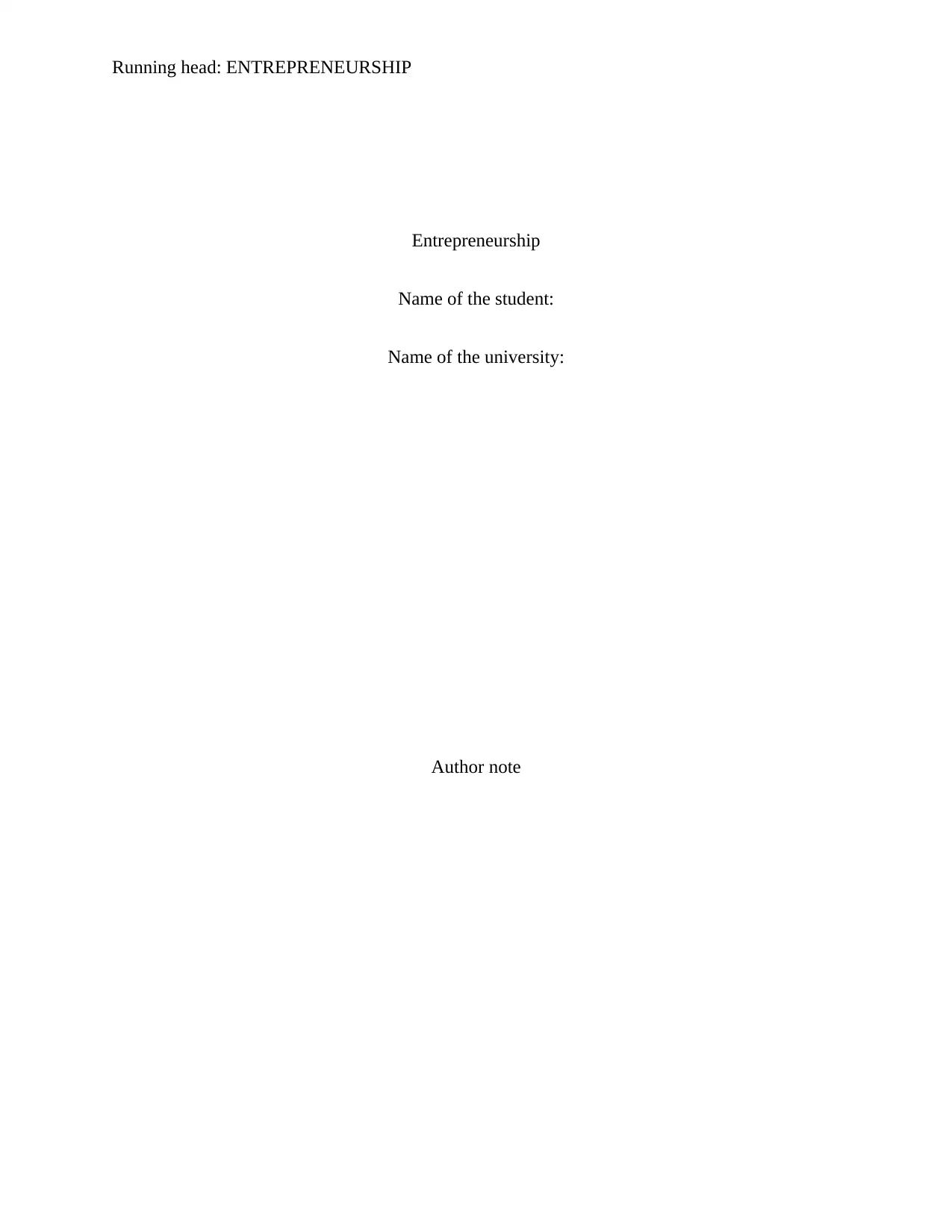
Running head: ENTREPRENEURSHIP
Entrepreneurship
Name of the student:
Name of the university:
Author note
Entrepreneurship
Name of the student:
Name of the university:
Author note
Paraphrase This Document
Need a fresh take? Get an instant paraphrase of this document with our AI Paraphraser
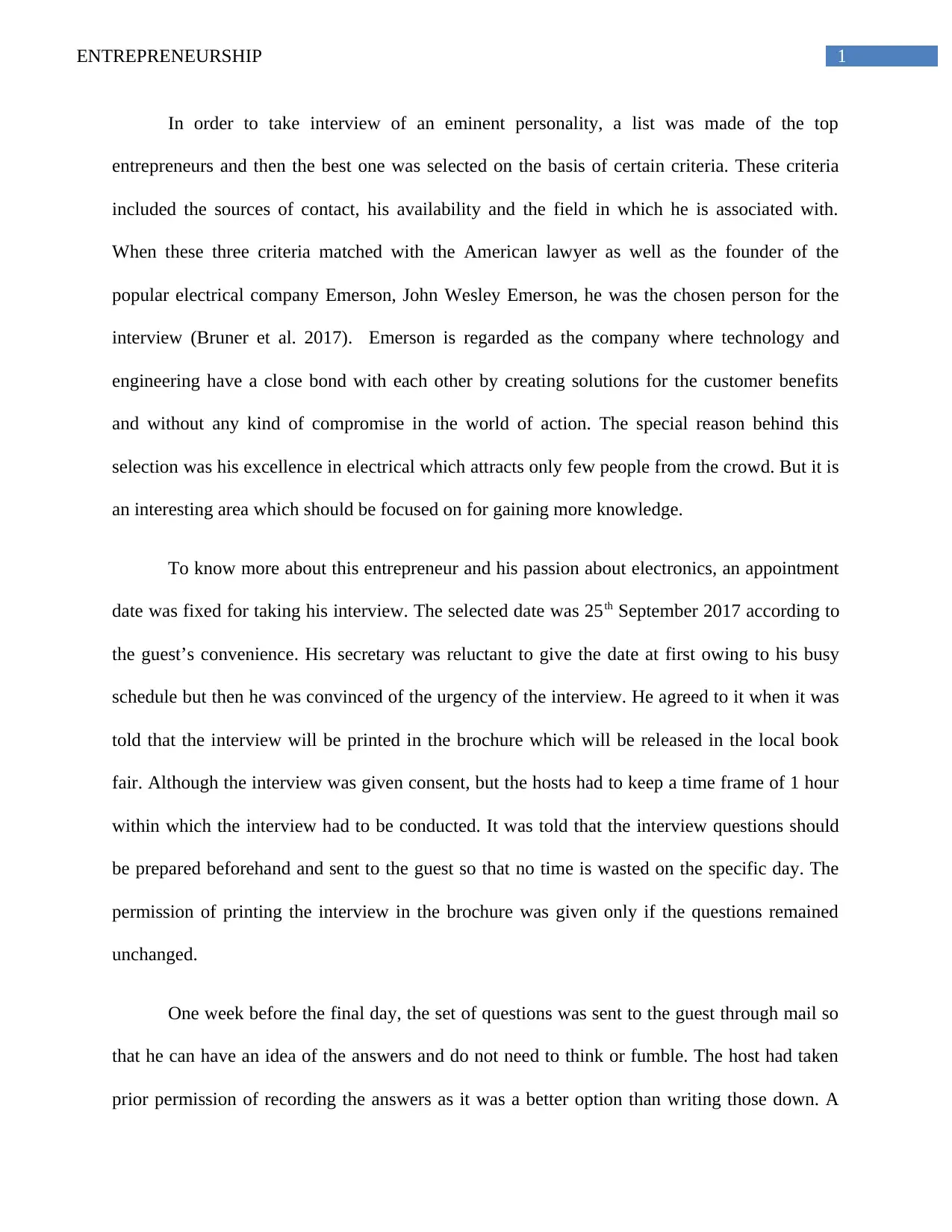
1ENTREPRENEURSHIP
In order to take interview of an eminent personality, a list was made of the top
entrepreneurs and then the best one was selected on the basis of certain criteria. These criteria
included the sources of contact, his availability and the field in which he is associated with.
When these three criteria matched with the American lawyer as well as the founder of the
popular electrical company Emerson, John Wesley Emerson, he was the chosen person for the
interview (Bruner et al. 2017). Emerson is regarded as the company where technology and
engineering have a close bond with each other by creating solutions for the customer benefits
and without any kind of compromise in the world of action. The special reason behind this
selection was his excellence in electrical which attracts only few people from the crowd. But it is
an interesting area which should be focused on for gaining more knowledge.
To know more about this entrepreneur and his passion about electronics, an appointment
date was fixed for taking his interview. The selected date was 25th September 2017 according to
the guest’s convenience. His secretary was reluctant to give the date at first owing to his busy
schedule but then he was convinced of the urgency of the interview. He agreed to it when it was
told that the interview will be printed in the brochure which will be released in the local book
fair. Although the interview was given consent, but the hosts had to keep a time frame of 1 hour
within which the interview had to be conducted. It was told that the interview questions should
be prepared beforehand and sent to the guest so that no time is wasted on the specific day. The
permission of printing the interview in the brochure was given only if the questions remained
unchanged.
One week before the final day, the set of questions was sent to the guest through mail so
that he can have an idea of the answers and do not need to think or fumble. The host had taken
prior permission of recording the answers as it was a better option than writing those down. A
In order to take interview of an eminent personality, a list was made of the top
entrepreneurs and then the best one was selected on the basis of certain criteria. These criteria
included the sources of contact, his availability and the field in which he is associated with.
When these three criteria matched with the American lawyer as well as the founder of the
popular electrical company Emerson, John Wesley Emerson, he was the chosen person for the
interview (Bruner et al. 2017). Emerson is regarded as the company where technology and
engineering have a close bond with each other by creating solutions for the customer benefits
and without any kind of compromise in the world of action. The special reason behind this
selection was his excellence in electrical which attracts only few people from the crowd. But it is
an interesting area which should be focused on for gaining more knowledge.
To know more about this entrepreneur and his passion about electronics, an appointment
date was fixed for taking his interview. The selected date was 25th September 2017 according to
the guest’s convenience. His secretary was reluctant to give the date at first owing to his busy
schedule but then he was convinced of the urgency of the interview. He agreed to it when it was
told that the interview will be printed in the brochure which will be released in the local book
fair. Although the interview was given consent, but the hosts had to keep a time frame of 1 hour
within which the interview had to be conducted. It was told that the interview questions should
be prepared beforehand and sent to the guest so that no time is wasted on the specific day. The
permission of printing the interview in the brochure was given only if the questions remained
unchanged.
One week before the final day, the set of questions was sent to the guest through mail so
that he can have an idea of the answers and do not need to think or fumble. The host had taken
prior permission of recording the answers as it was a better option than writing those down. A
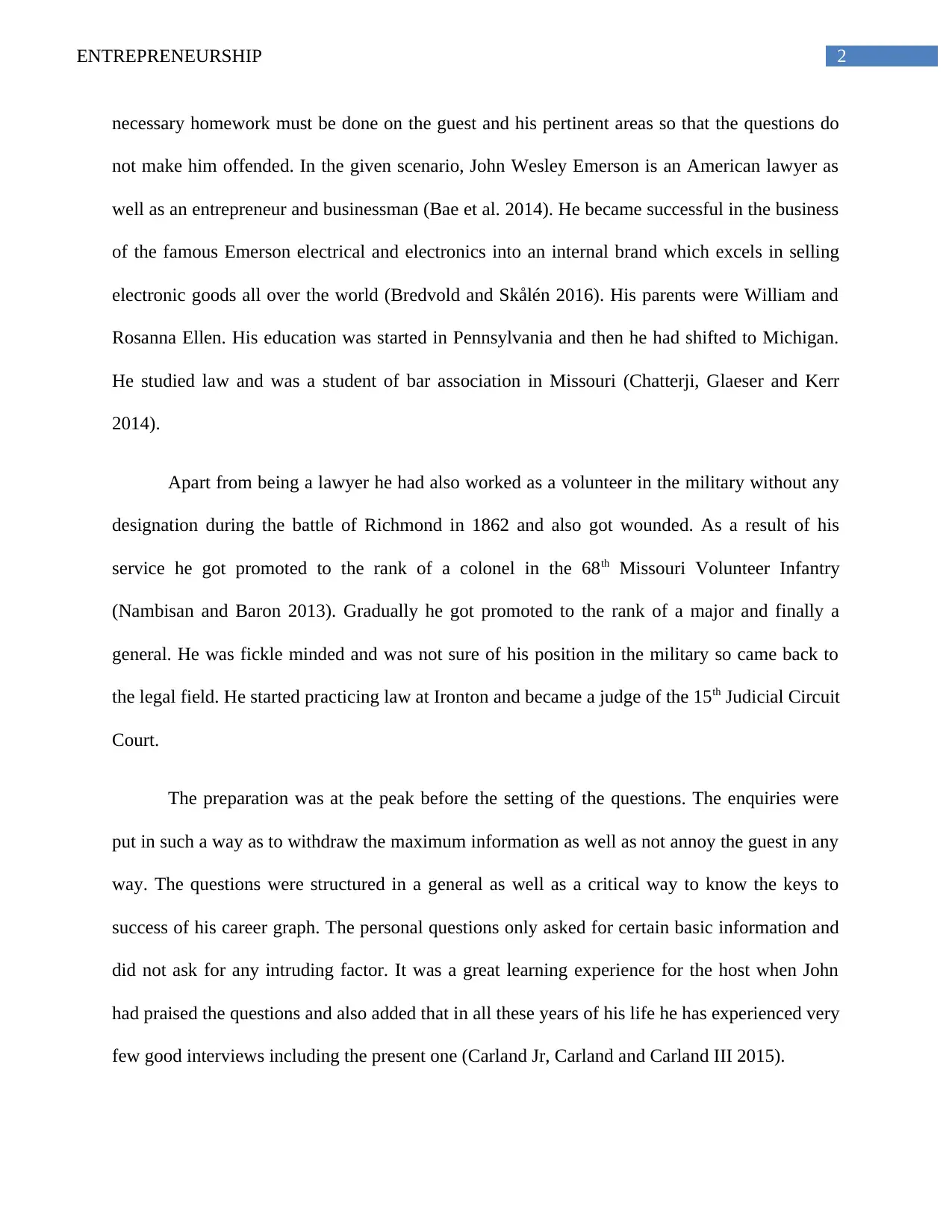
2ENTREPRENEURSHIP
necessary homework must be done on the guest and his pertinent areas so that the questions do
not make him offended. In the given scenario, John Wesley Emerson is an American lawyer as
well as an entrepreneur and businessman (Bae et al. 2014). He became successful in the business
of the famous Emerson electrical and electronics into an internal brand which excels in selling
electronic goods all over the world (Bredvold and Skålén 2016). His parents were William and
Rosanna Ellen. His education was started in Pennsylvania and then he had shifted to Michigan.
He studied law and was a student of bar association in Missouri (Chatterji, Glaeser and Kerr
2014).
Apart from being a lawyer he had also worked as a volunteer in the military without any
designation during the battle of Richmond in 1862 and also got wounded. As a result of his
service he got promoted to the rank of a colonel in the 68th Missouri Volunteer Infantry
(Nambisan and Baron 2013). Gradually he got promoted to the rank of a major and finally a
general. He was fickle minded and was not sure of his position in the military so came back to
the legal field. He started practicing law at Ironton and became a judge of the 15th Judicial Circuit
Court.
The preparation was at the peak before the setting of the questions. The enquiries were
put in such a way as to withdraw the maximum information as well as not annoy the guest in any
way. The questions were structured in a general as well as a critical way to know the keys to
success of his career graph. The personal questions only asked for certain basic information and
did not ask for any intruding factor. It was a great learning experience for the host when John
had praised the questions and also added that in all these years of his life he has experienced very
few good interviews including the present one (Carland Jr, Carland and Carland III 2015).
necessary homework must be done on the guest and his pertinent areas so that the questions do
not make him offended. In the given scenario, John Wesley Emerson is an American lawyer as
well as an entrepreneur and businessman (Bae et al. 2014). He became successful in the business
of the famous Emerson electrical and electronics into an internal brand which excels in selling
electronic goods all over the world (Bredvold and Skålén 2016). His parents were William and
Rosanna Ellen. His education was started in Pennsylvania and then he had shifted to Michigan.
He studied law and was a student of bar association in Missouri (Chatterji, Glaeser and Kerr
2014).
Apart from being a lawyer he had also worked as a volunteer in the military without any
designation during the battle of Richmond in 1862 and also got wounded. As a result of his
service he got promoted to the rank of a colonel in the 68th Missouri Volunteer Infantry
(Nambisan and Baron 2013). Gradually he got promoted to the rank of a major and finally a
general. He was fickle minded and was not sure of his position in the military so came back to
the legal field. He started practicing law at Ironton and became a judge of the 15th Judicial Circuit
Court.
The preparation was at the peak before the setting of the questions. The enquiries were
put in such a way as to withdraw the maximum information as well as not annoy the guest in any
way. The questions were structured in a general as well as a critical way to know the keys to
success of his career graph. The personal questions only asked for certain basic information and
did not ask for any intruding factor. It was a great learning experience for the host when John
had praised the questions and also added that in all these years of his life he has experienced very
few good interviews including the present one (Carland Jr, Carland and Carland III 2015).
⊘ This is a preview!⊘
Do you want full access?
Subscribe today to unlock all pages.

Trusted by 1+ million students worldwide
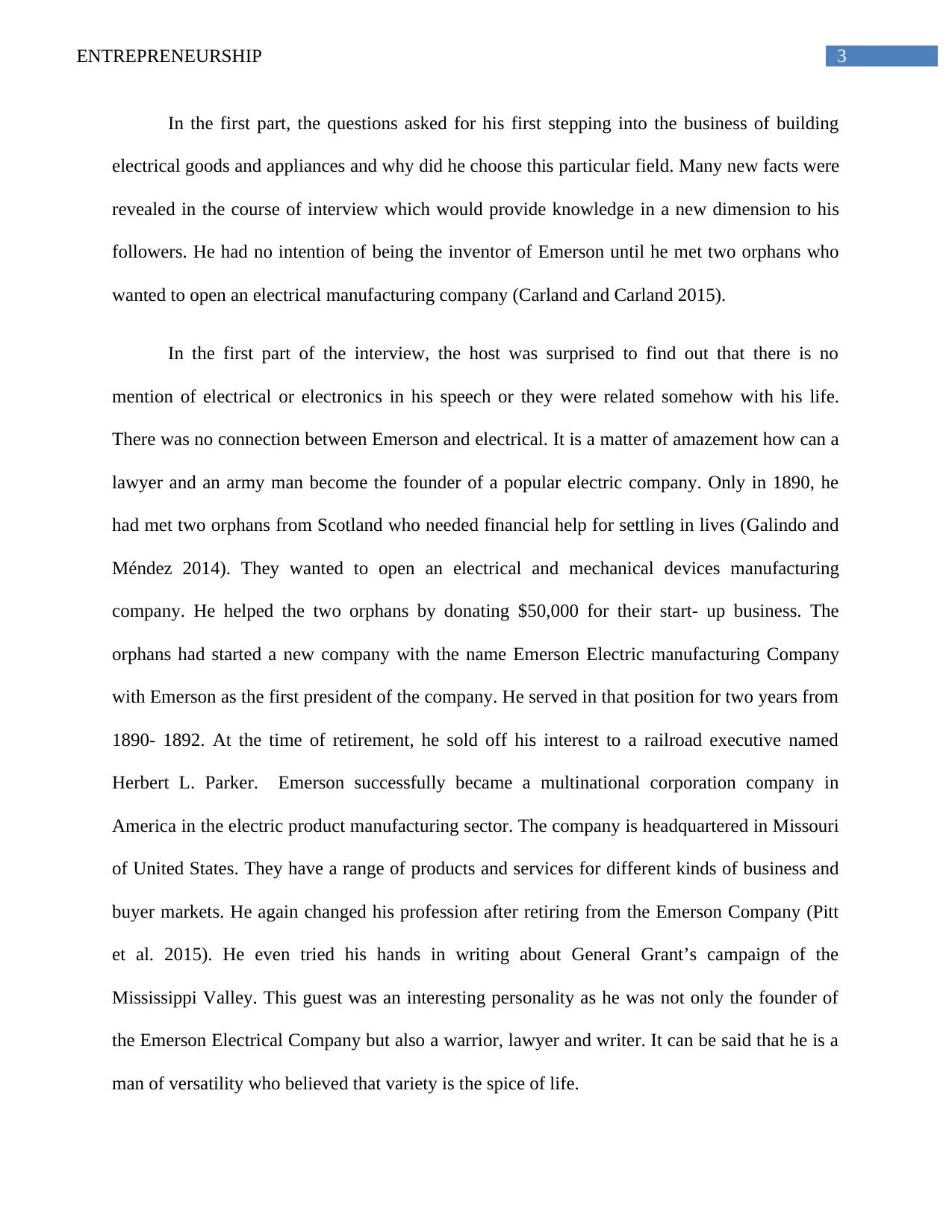
3ENTREPRENEURSHIP
In the first part, the questions asked for his first stepping into the business of building
electrical goods and appliances and why did he choose this particular field. Many new facts were
revealed in the course of interview which would provide knowledge in a new dimension to his
followers. He had no intention of being the inventor of Emerson until he met two orphans who
wanted to open an electrical manufacturing company (Carland and Carland 2015).
In the first part of the interview, the host was surprised to find out that there is no
mention of electrical or electronics in his speech or they were related somehow with his life.
There was no connection between Emerson and electrical. It is a matter of amazement how can a
lawyer and an army man become the founder of a popular electric company. Only in 1890, he
had met two orphans from Scotland who needed financial help for settling in lives (Galindo and
Méndez 2014). They wanted to open an electrical and mechanical devices manufacturing
company. He helped the two orphans by donating $50,000 for their start- up business. The
orphans had started a new company with the name Emerson Electric manufacturing Company
with Emerson as the first president of the company. He served in that position for two years from
1890- 1892. At the time of retirement, he sold off his interest to a railroad executive named
Herbert L. Parker. Emerson successfully became a multinational corporation company in
America in the electric product manufacturing sector. The company is headquartered in Missouri
of United States. They have a range of products and services for different kinds of business and
buyer markets. He again changed his profession after retiring from the Emerson Company (Pitt
et al. 2015). He even tried his hands in writing about General Grant’s campaign of the
Mississippi Valley. This guest was an interesting personality as he was not only the founder of
the Emerson Electrical Company but also a warrior, lawyer and writer. It can be said that he is a
man of versatility who believed that variety is the spice of life.
In the first part, the questions asked for his first stepping into the business of building
electrical goods and appliances and why did he choose this particular field. Many new facts were
revealed in the course of interview which would provide knowledge in a new dimension to his
followers. He had no intention of being the inventor of Emerson until he met two orphans who
wanted to open an electrical manufacturing company (Carland and Carland 2015).
In the first part of the interview, the host was surprised to find out that there is no
mention of electrical or electronics in his speech or they were related somehow with his life.
There was no connection between Emerson and electrical. It is a matter of amazement how can a
lawyer and an army man become the founder of a popular electric company. Only in 1890, he
had met two orphans from Scotland who needed financial help for settling in lives (Galindo and
Méndez 2014). They wanted to open an electrical and mechanical devices manufacturing
company. He helped the two orphans by donating $50,000 for their start- up business. The
orphans had started a new company with the name Emerson Electric manufacturing Company
with Emerson as the first president of the company. He served in that position for two years from
1890- 1892. At the time of retirement, he sold off his interest to a railroad executive named
Herbert L. Parker. Emerson successfully became a multinational corporation company in
America in the electric product manufacturing sector. The company is headquartered in Missouri
of United States. They have a range of products and services for different kinds of business and
buyer markets. He again changed his profession after retiring from the Emerson Company (Pitt
et al. 2015). He even tried his hands in writing about General Grant’s campaign of the
Mississippi Valley. This guest was an interesting personality as he was not only the founder of
the Emerson Electrical Company but also a warrior, lawyer and writer. It can be said that he is a
man of versatility who believed that variety is the spice of life.
Paraphrase This Document
Need a fresh take? Get an instant paraphrase of this document with our AI Paraphraser
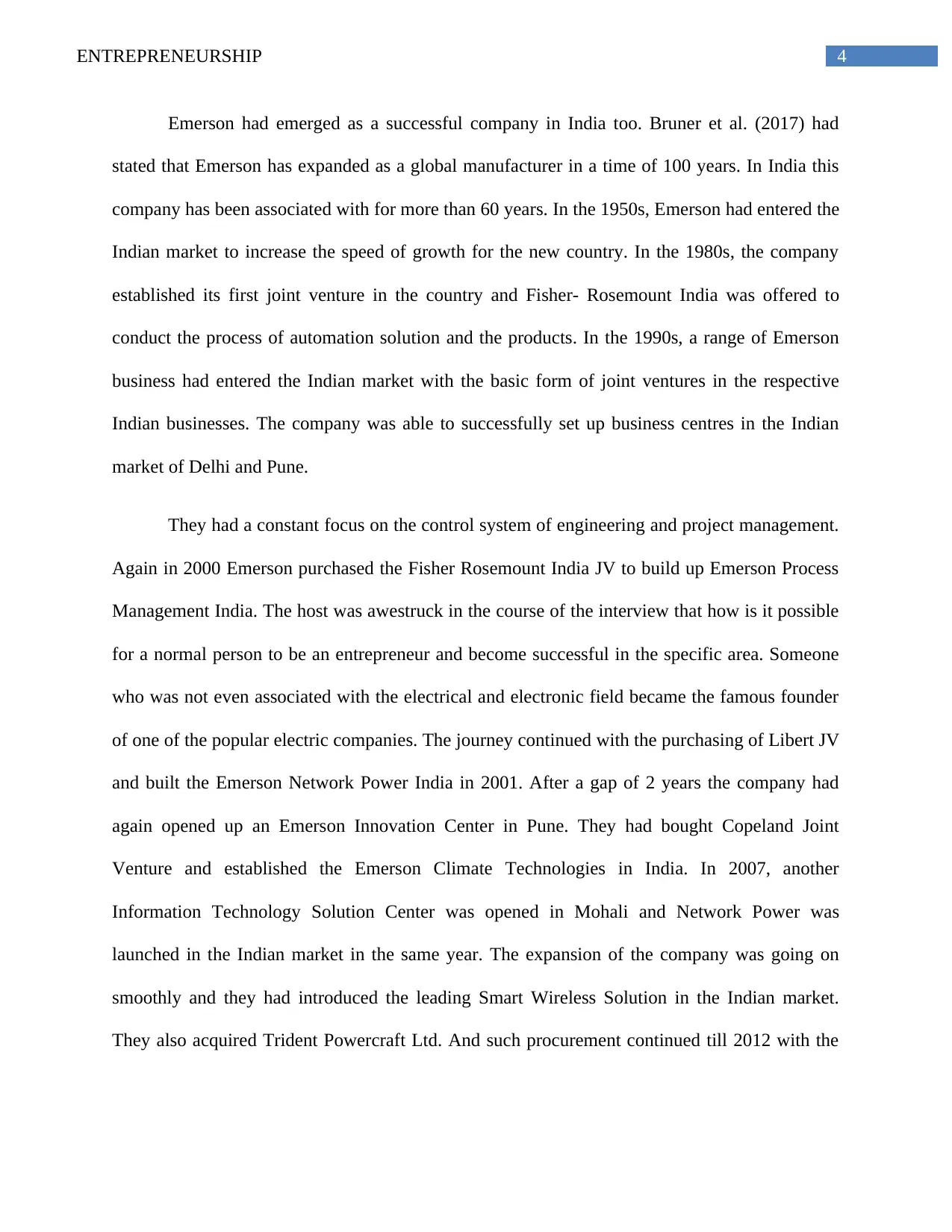
4ENTREPRENEURSHIP
Emerson had emerged as a successful company in India too. Bruner et al. (2017) had
stated that Emerson has expanded as a global manufacturer in a time of 100 years. In India this
company has been associated with for more than 60 years. In the 1950s, Emerson had entered the
Indian market to increase the speed of growth for the new country. In the 1980s, the company
established its first joint venture in the country and Fisher- Rosemount India was offered to
conduct the process of automation solution and the products. In the 1990s, a range of Emerson
business had entered the Indian market with the basic form of joint ventures in the respective
Indian businesses. The company was able to successfully set up business centres in the Indian
market of Delhi and Pune.
They had a constant focus on the control system of engineering and project management.
Again in 2000 Emerson purchased the Fisher Rosemount India JV to build up Emerson Process
Management India. The host was awestruck in the course of the interview that how is it possible
for a normal person to be an entrepreneur and become successful in the specific area. Someone
who was not even associated with the electrical and electronic field became the famous founder
of one of the popular electric companies. The journey continued with the purchasing of Libert JV
and built the Emerson Network Power India in 2001. After a gap of 2 years the company had
again opened up an Emerson Innovation Center in Pune. They had bought Copeland Joint
Venture and established the Emerson Climate Technologies in India. In 2007, another
Information Technology Solution Center was opened in Mohali and Network Power was
launched in the Indian market in the same year. The expansion of the company was going on
smoothly and they had introduced the leading Smart Wireless Solution in the Indian market.
They also acquired Trident Powercraft Ltd. And such procurement continued till 2012 with the
Emerson had emerged as a successful company in India too. Bruner et al. (2017) had
stated that Emerson has expanded as a global manufacturer in a time of 100 years. In India this
company has been associated with for more than 60 years. In the 1950s, Emerson had entered the
Indian market to increase the speed of growth for the new country. In the 1980s, the company
established its first joint venture in the country and Fisher- Rosemount India was offered to
conduct the process of automation solution and the products. In the 1990s, a range of Emerson
business had entered the Indian market with the basic form of joint ventures in the respective
Indian businesses. The company was able to successfully set up business centres in the Indian
market of Delhi and Pune.
They had a constant focus on the control system of engineering and project management.
Again in 2000 Emerson purchased the Fisher Rosemount India JV to build up Emerson Process
Management India. The host was awestruck in the course of the interview that how is it possible
for a normal person to be an entrepreneur and become successful in the specific area. Someone
who was not even associated with the electrical and electronic field became the famous founder
of one of the popular electric companies. The journey continued with the purchasing of Libert JV
and built the Emerson Network Power India in 2001. After a gap of 2 years the company had
again opened up an Emerson Innovation Center in Pune. They had bought Copeland Joint
Venture and established the Emerson Climate Technologies in India. In 2007, another
Information Technology Solution Center was opened in Mohali and Network Power was
launched in the Indian market in the same year. The expansion of the company was going on
smoothly and they had introduced the leading Smart Wireless Solution in the Indian market.
They also acquired Trident Powercraft Ltd. And such procurement continued till 2012 with the
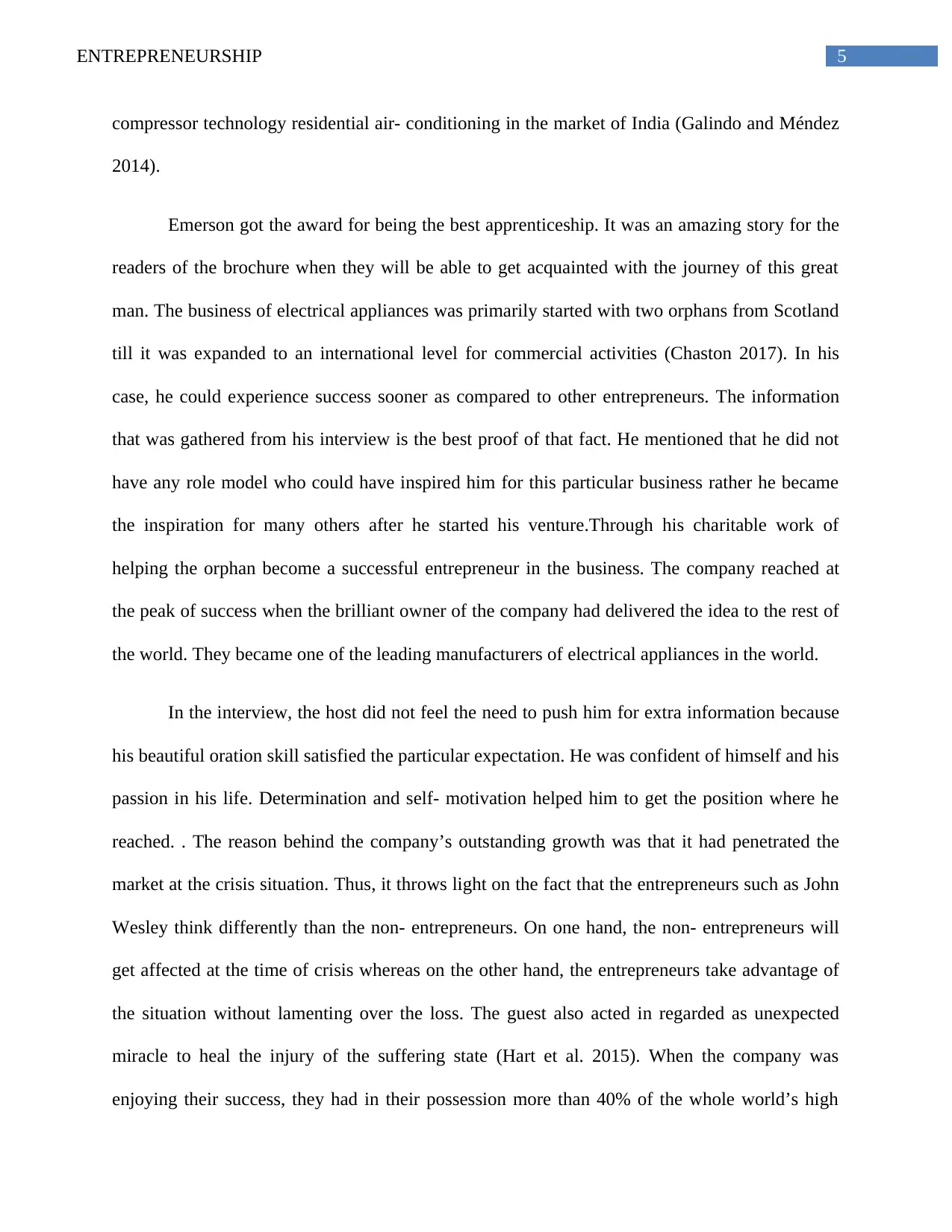
5ENTREPRENEURSHIP
compressor technology residential air- conditioning in the market of India (Galindo and Méndez
2014).
Emerson got the award for being the best apprenticeship. It was an amazing story for the
readers of the brochure when they will be able to get acquainted with the journey of this great
man. The business of electrical appliances was primarily started with two orphans from Scotland
till it was expanded to an international level for commercial activities (Chaston 2017). In his
case, he could experience success sooner as compared to other entrepreneurs. The information
that was gathered from his interview is the best proof of that fact. He mentioned that he did not
have any role model who could have inspired him for this particular business rather he became
the inspiration for many others after he started his venture.Through his charitable work of
helping the orphan become a successful entrepreneur in the business. The company reached at
the peak of success when the brilliant owner of the company had delivered the idea to the rest of
the world. They became one of the leading manufacturers of electrical appliances in the world.
In the interview, the host did not feel the need to push him for extra information because
his beautiful oration skill satisfied the particular expectation. He was confident of himself and his
passion in his life. Determination and self- motivation helped him to get the position where he
reached. . The reason behind the company’s outstanding growth was that it had penetrated the
market at the crisis situation. Thus, it throws light on the fact that the entrepreneurs such as John
Wesley think differently than the non- entrepreneurs. On one hand, the non- entrepreneurs will
get affected at the time of crisis whereas on the other hand, the entrepreneurs take advantage of
the situation without lamenting over the loss. The guest also acted in regarded as unexpected
miracle to heal the injury of the suffering state (Hart et al. 2015). When the company was
enjoying their success, they had in their possession more than 40% of the whole world’s high
compressor technology residential air- conditioning in the market of India (Galindo and Méndez
2014).
Emerson got the award for being the best apprenticeship. It was an amazing story for the
readers of the brochure when they will be able to get acquainted with the journey of this great
man. The business of electrical appliances was primarily started with two orphans from Scotland
till it was expanded to an international level for commercial activities (Chaston 2017). In his
case, he could experience success sooner as compared to other entrepreneurs. The information
that was gathered from his interview is the best proof of that fact. He mentioned that he did not
have any role model who could have inspired him for this particular business rather he became
the inspiration for many others after he started his venture.Through his charitable work of
helping the orphan become a successful entrepreneur in the business. The company reached at
the peak of success when the brilliant owner of the company had delivered the idea to the rest of
the world. They became one of the leading manufacturers of electrical appliances in the world.
In the interview, the host did not feel the need to push him for extra information because
his beautiful oration skill satisfied the particular expectation. He was confident of himself and his
passion in his life. Determination and self- motivation helped him to get the position where he
reached. . The reason behind the company’s outstanding growth was that it had penetrated the
market at the crisis situation. Thus, it throws light on the fact that the entrepreneurs such as John
Wesley think differently than the non- entrepreneurs. On one hand, the non- entrepreneurs will
get affected at the time of crisis whereas on the other hand, the entrepreneurs take advantage of
the situation without lamenting over the loss. The guest also acted in regarded as unexpected
miracle to heal the injury of the suffering state (Hart et al. 2015). When the company was
enjoying their success, they had in their possession more than 40% of the whole world’s high
⊘ This is a preview!⊘
Do you want full access?
Subscribe today to unlock all pages.

Trusted by 1+ million students worldwide
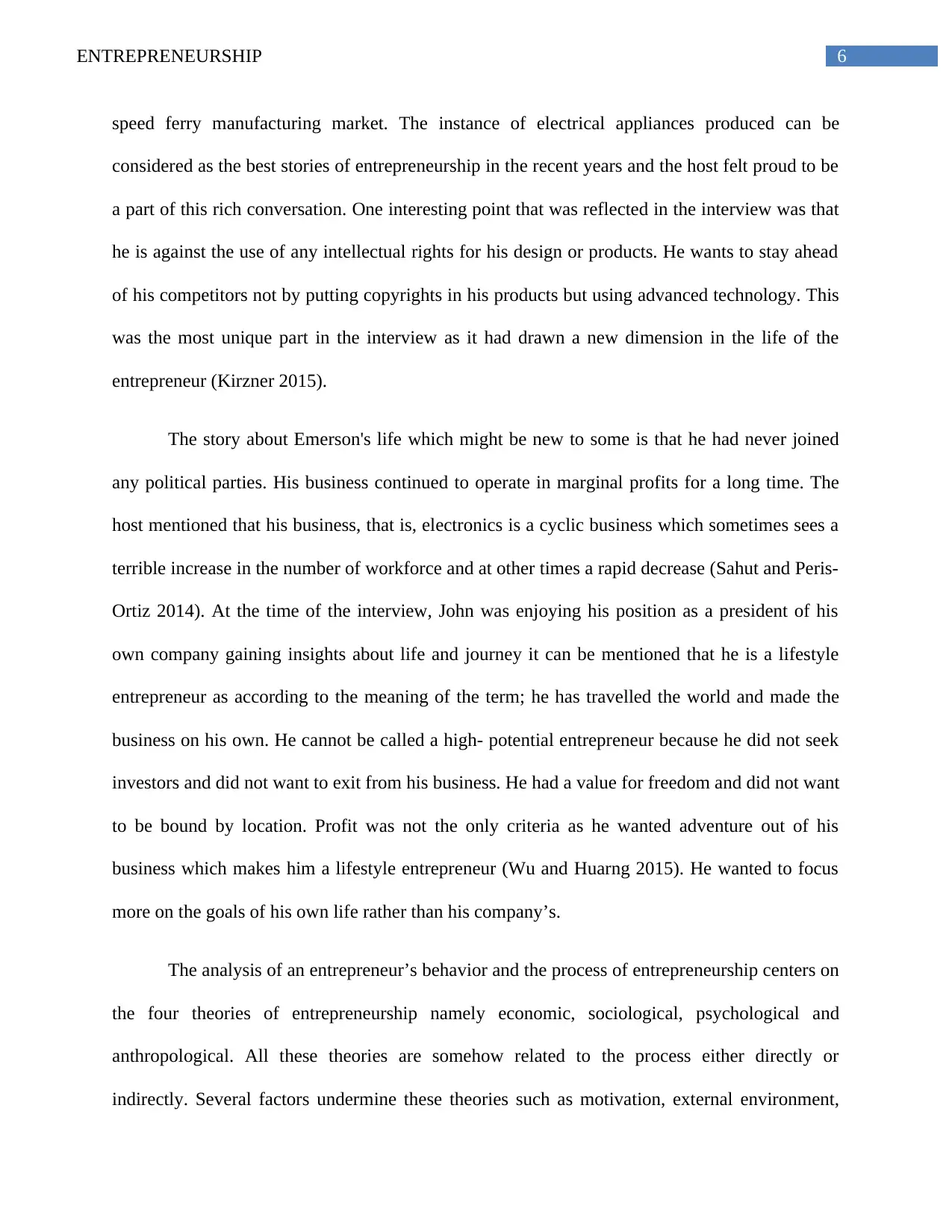
6ENTREPRENEURSHIP
speed ferry manufacturing market. The instance of electrical appliances produced can be
considered as the best stories of entrepreneurship in the recent years and the host felt proud to be
a part of this rich conversation. One interesting point that was reflected in the interview was that
he is against the use of any intellectual rights for his design or products. He wants to stay ahead
of his competitors not by putting copyrights in his products but using advanced technology. This
was the most unique part in the interview as it had drawn a new dimension in the life of the
entrepreneur (Kirzner 2015).
The story about Emerson's life which might be new to some is that he had never joined
any political parties. His business continued to operate in marginal profits for a long time. The
host mentioned that his business, that is, electronics is a cyclic business which sometimes sees a
terrible increase in the number of workforce and at other times a rapid decrease (Sahut and Peris-
Ortiz 2014). At the time of the interview, John was enjoying his position as a president of his
own company gaining insights about life and journey it can be mentioned that he is a lifestyle
entrepreneur as according to the meaning of the term; he has travelled the world and made the
business on his own. He cannot be called a high- potential entrepreneur because he did not seek
investors and did not want to exit from his business. He had a value for freedom and did not want
to be bound by location. Profit was not the only criteria as he wanted adventure out of his
business which makes him a lifestyle entrepreneur (Wu and Huarng 2015). He wanted to focus
more on the goals of his own life rather than his company’s.
The analysis of an entrepreneur’s behavior and the process of entrepreneurship centers on
the four theories of entrepreneurship namely economic, sociological, psychological and
anthropological. All these theories are somehow related to the process either directly or
indirectly. Several factors undermine these theories such as motivation, external environment,
speed ferry manufacturing market. The instance of electrical appliances produced can be
considered as the best stories of entrepreneurship in the recent years and the host felt proud to be
a part of this rich conversation. One interesting point that was reflected in the interview was that
he is against the use of any intellectual rights for his design or products. He wants to stay ahead
of his competitors not by putting copyrights in his products but using advanced technology. This
was the most unique part in the interview as it had drawn a new dimension in the life of the
entrepreneur (Kirzner 2015).
The story about Emerson's life which might be new to some is that he had never joined
any political parties. His business continued to operate in marginal profits for a long time. The
host mentioned that his business, that is, electronics is a cyclic business which sometimes sees a
terrible increase in the number of workforce and at other times a rapid decrease (Sahut and Peris-
Ortiz 2014). At the time of the interview, John was enjoying his position as a president of his
own company gaining insights about life and journey it can be mentioned that he is a lifestyle
entrepreneur as according to the meaning of the term; he has travelled the world and made the
business on his own. He cannot be called a high- potential entrepreneur because he did not seek
investors and did not want to exit from his business. He had a value for freedom and did not want
to be bound by location. Profit was not the only criteria as he wanted adventure out of his
business which makes him a lifestyle entrepreneur (Wu and Huarng 2015). He wanted to focus
more on the goals of his own life rather than his company’s.
The analysis of an entrepreneur’s behavior and the process of entrepreneurship centers on
the four theories of entrepreneurship namely economic, sociological, psychological and
anthropological. All these theories are somehow related to the process either directly or
indirectly. Several factors undermine these theories such as motivation, external environment,
Paraphrase This Document
Need a fresh take? Get an instant paraphrase of this document with our AI Paraphraser
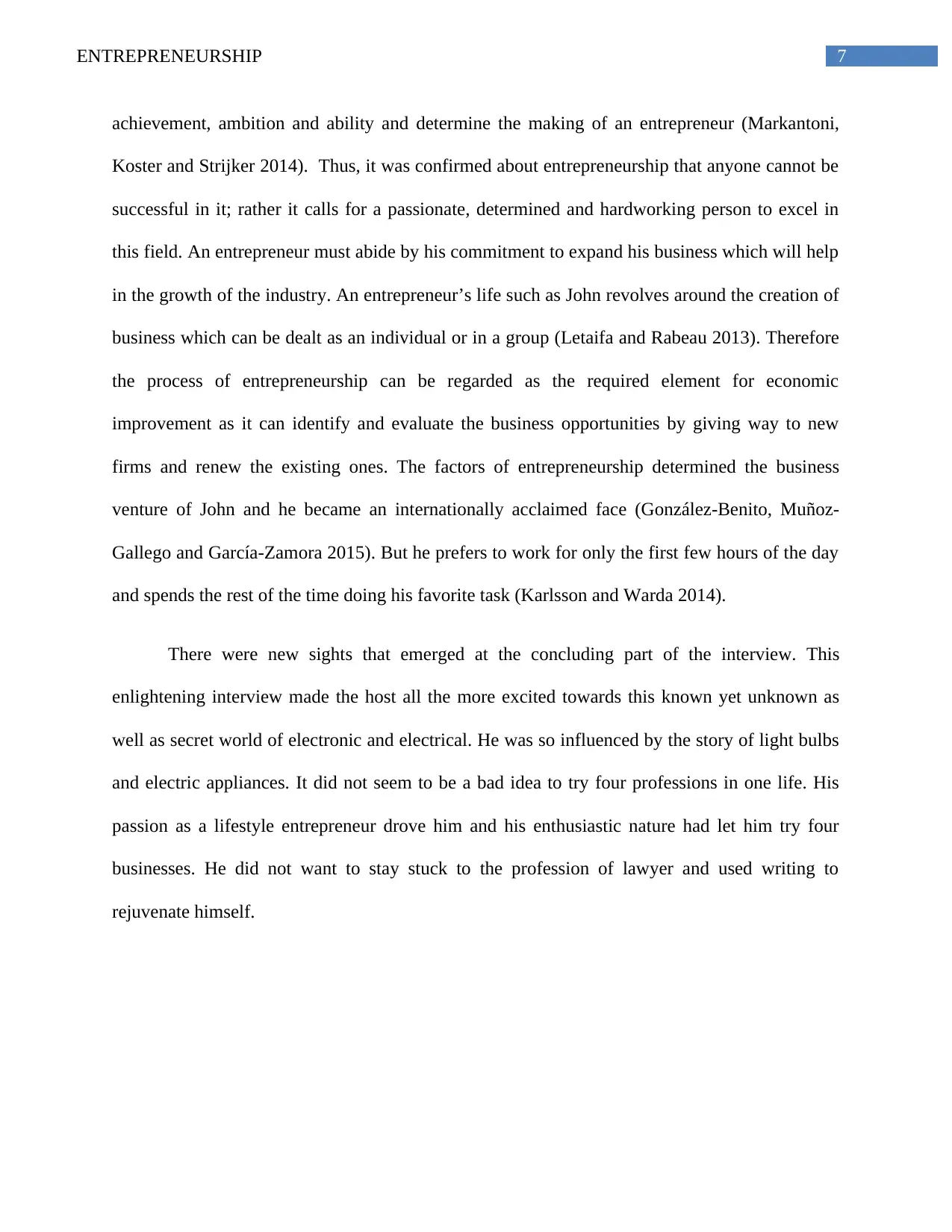
7ENTREPRENEURSHIP
achievement, ambition and ability and determine the making of an entrepreneur (Markantoni,
Koster and Strijker 2014). Thus, it was confirmed about entrepreneurship that anyone cannot be
successful in it; rather it calls for a passionate, determined and hardworking person to excel in
this field. An entrepreneur must abide by his commitment to expand his business which will help
in the growth of the industry. An entrepreneur’s life such as John revolves around the creation of
business which can be dealt as an individual or in a group (Letaifa and Rabeau 2013). Therefore
the process of entrepreneurship can be regarded as the required element for economic
improvement as it can identify and evaluate the business opportunities by giving way to new
firms and renew the existing ones. The factors of entrepreneurship determined the business
venture of John and he became an internationally acclaimed face (González-Benito, Muñoz-
Gallego and García-Zamora 2015). But he prefers to work for only the first few hours of the day
and spends the rest of the time doing his favorite task (Karlsson and Warda 2014).
There were new sights that emerged at the concluding part of the interview. This
enlightening interview made the host all the more excited towards this known yet unknown as
well as secret world of electronic and electrical. He was so influenced by the story of light bulbs
and electric appliances. It did not seem to be a bad idea to try four professions in one life. His
passion as a lifestyle entrepreneur drove him and his enthusiastic nature had let him try four
businesses. He did not want to stay stuck to the profession of lawyer and used writing to
rejuvenate himself.
achievement, ambition and ability and determine the making of an entrepreneur (Markantoni,
Koster and Strijker 2014). Thus, it was confirmed about entrepreneurship that anyone cannot be
successful in it; rather it calls for a passionate, determined and hardworking person to excel in
this field. An entrepreneur must abide by his commitment to expand his business which will help
in the growth of the industry. An entrepreneur’s life such as John revolves around the creation of
business which can be dealt as an individual or in a group (Letaifa and Rabeau 2013). Therefore
the process of entrepreneurship can be regarded as the required element for economic
improvement as it can identify and evaluate the business opportunities by giving way to new
firms and renew the existing ones. The factors of entrepreneurship determined the business
venture of John and he became an internationally acclaimed face (González-Benito, Muñoz-
Gallego and García-Zamora 2015). But he prefers to work for only the first few hours of the day
and spends the rest of the time doing his favorite task (Karlsson and Warda 2014).
There were new sights that emerged at the concluding part of the interview. This
enlightening interview made the host all the more excited towards this known yet unknown as
well as secret world of electronic and electrical. He was so influenced by the story of light bulbs
and electric appliances. It did not seem to be a bad idea to try four professions in one life. His
passion as a lifestyle entrepreneur drove him and his enthusiastic nature had let him try four
businesses. He did not want to stay stuck to the profession of lawyer and used writing to
rejuvenate himself.
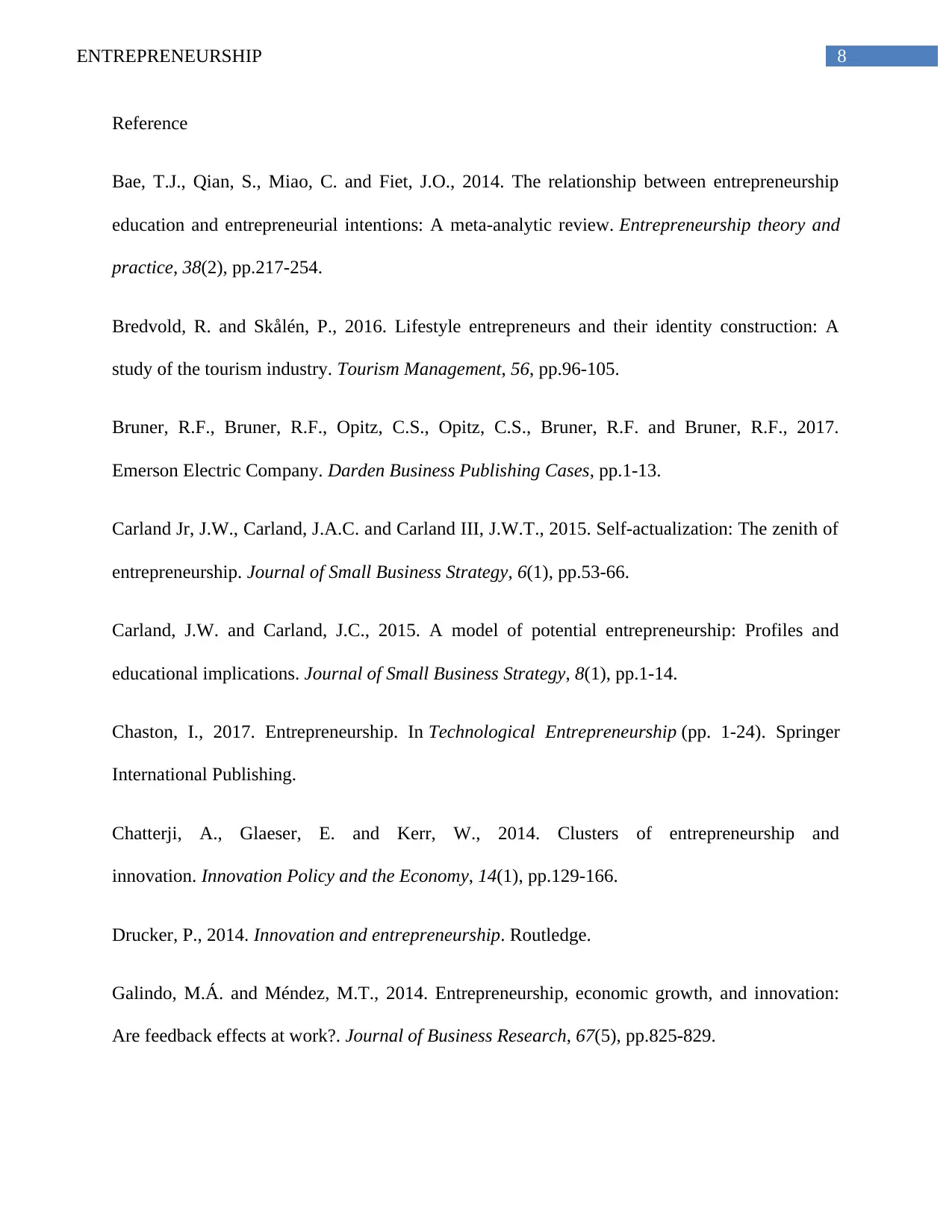
8ENTREPRENEURSHIP
Reference
Bae, T.J., Qian, S., Miao, C. and Fiet, J.O., 2014. The relationship between entrepreneurship
education and entrepreneurial intentions: A meta‐analytic review. Entrepreneurship theory and
practice, 38(2), pp.217-254.
Bredvold, R. and Skålén, P., 2016. Lifestyle entrepreneurs and their identity construction: A
study of the tourism industry. Tourism Management, 56, pp.96-105.
Bruner, R.F., Bruner, R.F., Opitz, C.S., Opitz, C.S., Bruner, R.F. and Bruner, R.F., 2017.
Emerson Electric Company. Darden Business Publishing Cases, pp.1-13.
Carland Jr, J.W., Carland, J.A.C. and Carland III, J.W.T., 2015. Self-actualization: The zenith of
entrepreneurship. Journal of Small Business Strategy, 6(1), pp.53-66.
Carland, J.W. and Carland, J.C., 2015. A model of potential entrepreneurship: Profiles and
educational implications. Journal of Small Business Strategy, 8(1), pp.1-14.
Chaston, I., 2017. Entrepreneurship. In Technological Entrepreneurship (pp. 1-24). Springer
International Publishing.
Chatterji, A., Glaeser, E. and Kerr, W., 2014. Clusters of entrepreneurship and
innovation. Innovation Policy and the Economy, 14(1), pp.129-166.
Drucker, P., 2014. Innovation and entrepreneurship. Routledge.
Galindo, M.Á. and Méndez, M.T., 2014. Entrepreneurship, economic growth, and innovation:
Are feedback effects at work?. Journal of Business Research, 67(5), pp.825-829.
Reference
Bae, T.J., Qian, S., Miao, C. and Fiet, J.O., 2014. The relationship between entrepreneurship
education and entrepreneurial intentions: A meta‐analytic review. Entrepreneurship theory and
practice, 38(2), pp.217-254.
Bredvold, R. and Skålén, P., 2016. Lifestyle entrepreneurs and their identity construction: A
study of the tourism industry. Tourism Management, 56, pp.96-105.
Bruner, R.F., Bruner, R.F., Opitz, C.S., Opitz, C.S., Bruner, R.F. and Bruner, R.F., 2017.
Emerson Electric Company. Darden Business Publishing Cases, pp.1-13.
Carland Jr, J.W., Carland, J.A.C. and Carland III, J.W.T., 2015. Self-actualization: The zenith of
entrepreneurship. Journal of Small Business Strategy, 6(1), pp.53-66.
Carland, J.W. and Carland, J.C., 2015. A model of potential entrepreneurship: Profiles and
educational implications. Journal of Small Business Strategy, 8(1), pp.1-14.
Chaston, I., 2017. Entrepreneurship. In Technological Entrepreneurship (pp. 1-24). Springer
International Publishing.
Chatterji, A., Glaeser, E. and Kerr, W., 2014. Clusters of entrepreneurship and
innovation. Innovation Policy and the Economy, 14(1), pp.129-166.
Drucker, P., 2014. Innovation and entrepreneurship. Routledge.
Galindo, M.Á. and Méndez, M.T., 2014. Entrepreneurship, economic growth, and innovation:
Are feedback effects at work?. Journal of Business Research, 67(5), pp.825-829.
⊘ This is a preview!⊘
Do you want full access?
Subscribe today to unlock all pages.

Trusted by 1+ million students worldwide
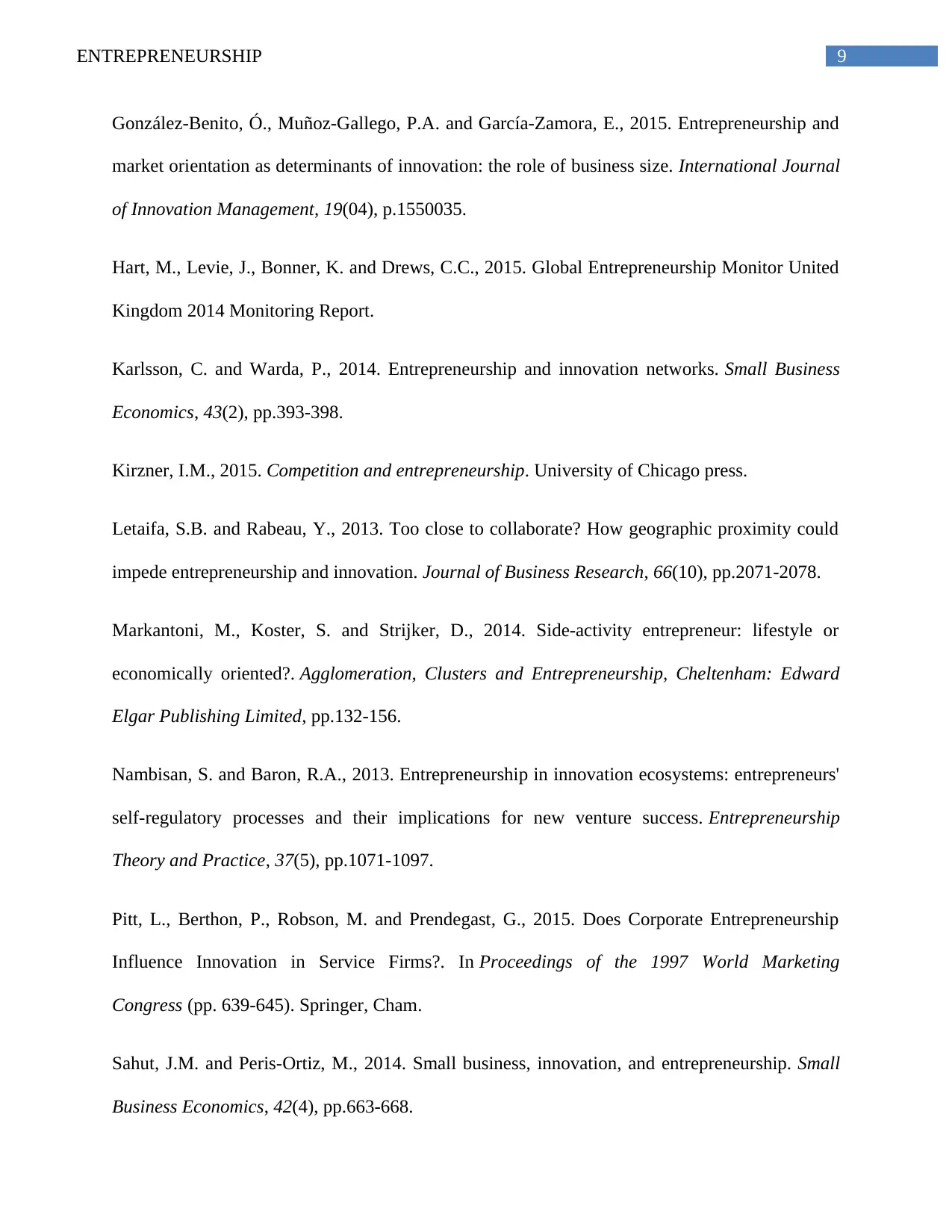
9ENTREPRENEURSHIP
González-Benito, Ó., Muñoz-Gallego, P.A. and García-Zamora, E., 2015. Entrepreneurship and
market orientation as determinants of innovation: the role of business size. International Journal
of Innovation Management, 19(04), p.1550035.
Hart, M., Levie, J., Bonner, K. and Drews, C.C., 2015. Global Entrepreneurship Monitor United
Kingdom 2014 Monitoring Report.
Karlsson, C. and Warda, P., 2014. Entrepreneurship and innovation networks. Small Business
Economics, 43(2), pp.393-398.
Kirzner, I.M., 2015. Competition and entrepreneurship. University of Chicago press.
Letaifa, S.B. and Rabeau, Y., 2013. Too close to collaborate? How geographic proximity could
impede entrepreneurship and innovation. Journal of Business Research, 66(10), pp.2071-2078.
Markantoni, M., Koster, S. and Strijker, D., 2014. Side-activity entrepreneur: lifestyle or
economically oriented?. Agglomeration, Clusters and Entrepreneurship, Cheltenham: Edward
Elgar Publishing Limited, pp.132-156.
Nambisan, S. and Baron, R.A., 2013. Entrepreneurship in innovation ecosystems: entrepreneurs'
self‐regulatory processes and their implications for new venture success. Entrepreneurship
Theory and Practice, 37(5), pp.1071-1097.
Pitt, L., Berthon, P., Robson, M. and Prendegast, G., 2015. Does Corporate Entrepreneurship
Influence Innovation in Service Firms?. In Proceedings of the 1997 World Marketing
Congress (pp. 639-645). Springer, Cham.
Sahut, J.M. and Peris-Ortiz, M., 2014. Small business, innovation, and entrepreneurship. Small
Business Economics, 42(4), pp.663-668.
González-Benito, Ó., Muñoz-Gallego, P.A. and García-Zamora, E., 2015. Entrepreneurship and
market orientation as determinants of innovation: the role of business size. International Journal
of Innovation Management, 19(04), p.1550035.
Hart, M., Levie, J., Bonner, K. and Drews, C.C., 2015. Global Entrepreneurship Monitor United
Kingdom 2014 Monitoring Report.
Karlsson, C. and Warda, P., 2014. Entrepreneurship and innovation networks. Small Business
Economics, 43(2), pp.393-398.
Kirzner, I.M., 2015. Competition and entrepreneurship. University of Chicago press.
Letaifa, S.B. and Rabeau, Y., 2013. Too close to collaborate? How geographic proximity could
impede entrepreneurship and innovation. Journal of Business Research, 66(10), pp.2071-2078.
Markantoni, M., Koster, S. and Strijker, D., 2014. Side-activity entrepreneur: lifestyle or
economically oriented?. Agglomeration, Clusters and Entrepreneurship, Cheltenham: Edward
Elgar Publishing Limited, pp.132-156.
Nambisan, S. and Baron, R.A., 2013. Entrepreneurship in innovation ecosystems: entrepreneurs'
self‐regulatory processes and their implications for new venture success. Entrepreneurship
Theory and Practice, 37(5), pp.1071-1097.
Pitt, L., Berthon, P., Robson, M. and Prendegast, G., 2015. Does Corporate Entrepreneurship
Influence Innovation in Service Firms?. In Proceedings of the 1997 World Marketing
Congress (pp. 639-645). Springer, Cham.
Sahut, J.M. and Peris-Ortiz, M., 2014. Small business, innovation, and entrepreneurship. Small
Business Economics, 42(4), pp.663-668.
Paraphrase This Document
Need a fresh take? Get an instant paraphrase of this document with our AI Paraphraser
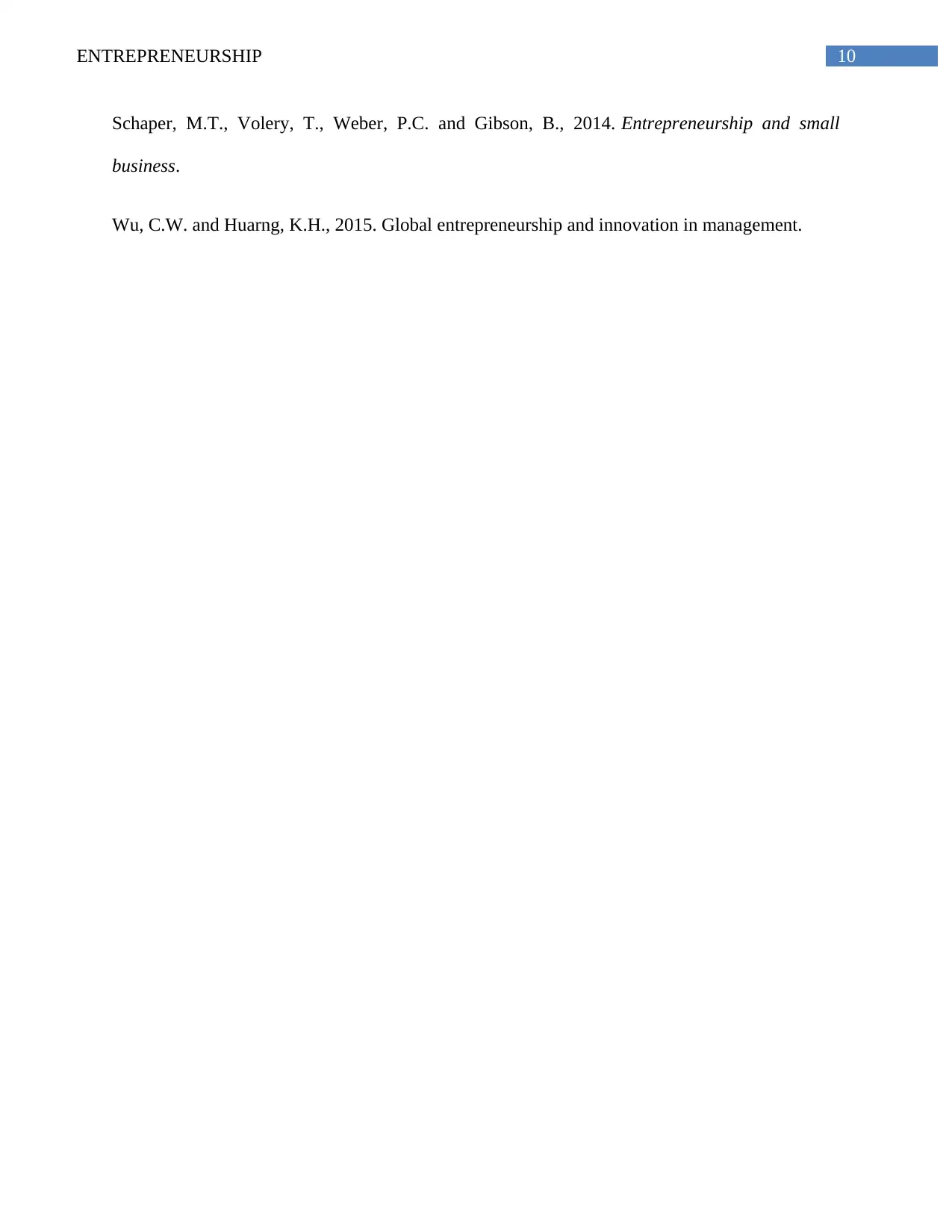
10ENTREPRENEURSHIP
Schaper, M.T., Volery, T., Weber, P.C. and Gibson, B., 2014. Entrepreneurship and small
business.
Wu, C.W. and Huarng, K.H., 2015. Global entrepreneurship and innovation in management.
Schaper, M.T., Volery, T., Weber, P.C. and Gibson, B., 2014. Entrepreneurship and small
business.
Wu, C.W. and Huarng, K.H., 2015. Global entrepreneurship and innovation in management.
1 out of 11
Your All-in-One AI-Powered Toolkit for Academic Success.
+13062052269
info@desklib.com
Available 24*7 on WhatsApp / Email
![[object Object]](/_next/static/media/star-bottom.7253800d.svg)
Unlock your academic potential
Copyright © 2020–2025 A2Z Services. All Rights Reserved. Developed and managed by ZUCOL.